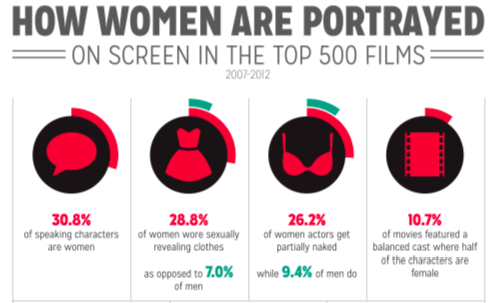- Meghana Addla Suneel
A majority of people
consciously or unconsciously believe that movies, or for that matter media in
general, are often said to be the reflection of the society. It has been the
topic of discussion that media truly reflects the society, there's no doubt that
media have a big socio-cultural influence on the society. As far as showing
women in advertisements of recent times too, a woman's advertisements are a
concern with things which have only worsened over time. In most advertisements
of recent times too, a woman is either washing clothes or utensils, cooking
serving food to family members or trying to make her husband feel better who's
at that time reading newspaper or suffering from cold. A woman does all the
household chores even when she has a headache or backache. They reinforce the
age old belief that a woman is supposed to forgo her own comfort and keep on
doing household chores without getting tired.
Women have often suffered from narrow representations in media. They are often
linked to the domestic situation (women as house wives or mothers). Or as sex
objects (sexualized and objectified) represented to entertain and titillate the
male audience.
Media plays a large role in creating social norms, because various forms of
media, including advertisements, television, and film, are present almost
everywhere in current culture. Gender roles, as example, exist solely because
society as a whole chooses to accept them but, they are perpetuated by the
media. Conspicuous viewers must be aware of what the media is presenting to
them, and make sure they're not actively participating in a culture of
oppression.
New media can be a platform for the objectification of women and girls from
everyday hyper-sexualized, one-dimensional images of women and girls to overt violence.
Researchers report that women's magazines have one-half times more ads and
articles promoting weight loss than men's magazine. Television and movies
reinforce the importance of a thin body as measures of a women's worth. In
recent reports over three-quarter of female characters about their bodies.
Research indicates that exposure to image of thin young air-brushed female
bodies can be linked to depression, loss of self-esteem and the development of
unhealthy eating habits in women and girls. Twenty years ago the average model
weighed 8 percent less than the average woman, but today's model weight is 23
percent less than the average woman. The message that the media sends to women
about thinness, dieting, and beauty tells "ordinary" women that they
are always in need of adjustments, and that the female body is object to be
perfected.
HOW WOMEN ARE PORTRAYED IN THE MEDIA:
THEN vs. NOW
Throughout history,
women are shown as the inferior sex. The Women's Suffrage Movement lasted from
1848-1920 when the 19th Amendment was ratified on August 26th, 1920 the 19th
amendment gave women the right to vote. Famous women throughout the history
Marie Curie- first women to win Nobel Peace Prize for two separate
categories(Radioactivity and chemistry). Eleanor Roosevelt head of UN Human
Rights commission and helped draft the 1948 UN declaration of Human Rights.
Susan B Anthony 19th century women's movements most powerful organizer.
The ideal body is only
obtained by 5% of American Females. Approximately 47% of girls in middle school
to high school admitted to lose weight from looking at magazine pictures. 81%
of pre- teens admitted to be afraid of becoming "fat". 42% of young
elementary students want to be skinnier. Roughly one half of girls in the
fourth grade are on diets. Nearly 55% of girls near the age of thirteen were
already unhappy about their bodies .97% of women admit to hating their bodies
81% of 10 year old girls experience a fear of being fat.9/10 of girls who are
in high school, juniors and seniors diet while only 1/10 of girls are
overweight.
Many advertisements
feature women as an object or with the main feature as their body. Almost all
pictures you see in magazines, billboards and other mass media are retouched.
EXPLOITATION
OF WOMEN IN MASS MEDIA
The exploitation of
women in mass media is the use or portrayal of women in mass media (such as
television, film and advertising) to increase the appeal of the media or
product to the detriment of, or without regard to the interest of the women
portrayed, or women in general. Feminists and other advocates of women's right
have criticized such exploitation. The most often criticized aspect of the use
of women in mass media is sexual objectification, but dismemberment can be a
part of the objectification as well.
Women in advertisements:
Research has shown that
advertising can manipulate and distort images of women in the media, to create
a stereotype of women as sex objects. It has also been proven that men almost
always appear with complete clothes while women are constantly portrayed as
wearing less clothing, which come back to the issue of women being portrayed
more as sex objects than men. Women mostly have ads that sell beauty and
clothes in their magazines and not other ads such as ones that promote examples
of new technology or innovation. These ads are typically seen in male
magazines. Other ads in women magazines usually involved diet strategic and
pills, which give women an unrealistic image of what society wants them to look
like.
Women in soaps:
The term "soap
opera" was coined by the American press in the 1930s to denote the
extraordinarily popular genre of serialized domestic ratio dramas, which, by
1940, represented some 90% of all commercially sponsored day time broadcast
hours. The "soap" in soap opera alluded to their sponsorship by
manufactures of household cleaning products; while opera suggested an
incongruity between the domestic narrative concerns of the daytime serial and
the most elevated of dramatic forms. The term itself signals an aesthetic and
cultural incongruity the events of everyday life elevated to the subject matter
of an operatic form. Most of these daily dramas revolve around complexities of
family, marriage and relationships. Since these serials are immensely popular,
they have a great impact on our minds: the way we perceive others, the society
and their roles in that society. These characters carry decisive attributes
which are depicted via the plot. These attributes influence our outlook. We
tend to judge others based on these created archetypes. A good woman, according
to Indian serials, is an ideal homemaker. Her world revolves around her family
and her home. Her family's/husband's opinion becomes her opinion.
Women in films:
Women have mainly
played decorative objects in Hindi cinema for a long time. Or even in films
where they had important roles, they are more victims and martyrs or
victimizers of other women. There are rarely films which show women as strong
women who can raise their voice against injustice, who can rebel in their own
way and make their own political statement.
Women in music videos:
Women are objectified
in music videos, especially in hip hop and rap; from sexy dressing, speaking in
seductive tones to acting and dancing in a sexual manner. -the perfect
portrayal of women as sex objects. Sometimes in music videos, the woman's face
is not shown. Instead her body becomes a showpiece and is put on display. It
depicts her as not having an identity or a sense of individualism thus,
reinforcing her role as a sex symbol.
ISSUES
OF THE PORTRAYAL OF WOMEN IN MASS MEDIA AND FILM
We look at advertisements
today, we see skinny beautiful women with flawless hair and makeup. Women are
told that this is what we are supposed to look like all times, but we don't and
neither do the models. Today, women are held to such high and unrealistic
beauty standards that have recently been created by the media and
advertisements. This issue points to the immediate problem with the portrayal
of women. The issue is that we are taught to think in binary. Binary thinking
means that we only see two options, which are usually opposing. For example,
pretty and ugly , fat and skinny, tall and short, happy and sad-the list goes
on. It is ultimately due to this binary thinking that women are held to these
standards. Women on covers of magazines that even they do not really look like.
Each picture is edited after shoot and body fat is reduced, imperfections are
removed, and they are once again airbrushed. Remembered that modeling requires
healthy eating, constant exercise, hours of makeup and hair, and much more, yet
they are still not good enough to be placed on the front of magazine. They are
further manipulated and made even more beautiful, showing that even a model's
image is not good enough! One can't even begin to imagine what that does to
their self-image based on the fact that their job is to remain skinny and
beautiful, yet they are told that they are not good enough . This is why so
many models suffer with anorexia. Many celebrities and models have passed away
due to their anorexia, showing that models literally cannot get any skinnier
This unreal "skinny" portrayed in magazines gives unrealistic
standards to girls on how they should look. They can literally spend their
entire life trying to look like a model, but never will. This is why 90% of
people with eating disorders are females between the ages of 12and 25. The
problem is that women do not feel skinny, they automatically feel fat and lose
self-esteem. Furthermore, if we examine the concept of fat, we realize that its
negative connotation was recently created. Fat was term originally used to
describe body mass, which it still does today, but then why is it such a
negative term? Because we made it one! Fat does not connote ugly just as skinny
does not connote pretty. This then makes us question why begin described as fat
is negative, but being described as skinny is positive. Beauty was one used to
describe facial features, but it has recently been extended to the body as
well.
EFFECTS
ON WOMEN
·
69% of girls in one study said that
magazine models influence their idea of perfect body shape.
·
Exposure to the "ideal" body
images has been found to lower women's satisfaction with their own
attractiveness.
·
The average U.S woman is 5'4 and weighs
140 pounds whereas the average U.S model is 5'11 and weighs 117 pounds.
·
44% of women who are average or
underweight think they are overweight.
·
30% of women chose an ideally body shape
that is 20% underweight and additional 44% choose an ideal body shape that is
underweight.
·
Girls who were already dissatisfied with
their bodies showed more dieting, anxiety, and bulimic symptoms after prolonged
exposure to fashion and advertising images in a teen girl magazine.
EFFECTS ON SOCIETY
·
Women self-objectify in terms of body
surveillance by adopting a form of self-consciousness in which they habitually
monitor their own body's outward appearance and spend significant amounts of
attention on how others may perceive their physical appearance.
·
Unrealistic expectations by men of how
women should look or behave.
·
Stereotyping of women who are positively
portrayed by or sexualized in the media, such as the theme of a dumb
blonde" or "blonde bimbo", limiting the societal and career
opportunities for people who fit these stereotypes.
·
Psychological disorders such as body
dysmorphic disorder, (BDD) anorexia, and bulimia.
·
The excessively coercive nature of
appeal to strong sexual instincts to sell products or promote media.
·
Increase in the likelihood and
acceptance of sexual violence.


